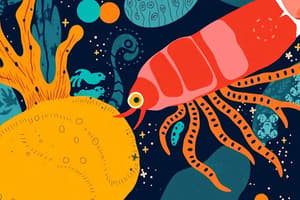Podcast
Questions and Answers
What are animals without a backbone called?
What are animals without a backbone called?
- Vertebrates
- Echinoderms
- Chordates
- Invertebrates (correct)
Which of the following are characteristics of animals?
Which of the following are characteristics of animals?
- Eukaryotic
- Multicellular
- Tissue-level organization
- All of the above (correct)
What are the three types of symmetry in body plans?
What are the three types of symmetry in body plans?
Radial, Bilateral, Asymmetrical
Which of these is NOT a marine invertebrate phylum?
Which of these is NOT a marine invertebrate phylum?
What are the basic characteristics of sponges?
What are the basic characteristics of sponges?
The cells that line the interior canals of sponges and create a water current are called __________.
The cells that line the interior canals of sponges and create a water current are called __________.
What are the two ways sponges reproduce?
What are the two ways sponges reproduce?
What type of symmetry do cnidarians generally exhibit?
What type of symmetry do cnidarians generally exhibit?
What purpose do nematocysts serve in cnidarians?
What purpose do nematocysts serve in cnidarians?
Cnidarians have a complete digestive system.
Cnidarians have a complete digestive system.
Match the types of cnidarians with their characteristics:
Match the types of cnidarians with their characteristics:
What are comb jellies characterized by?
What are comb jellies characterized by?
Flashcards
Invertebrates
Invertebrates
Animals without a backbone, comprising approximately 97% of all animal species.
Radial Symmetry
Radial Symmetry
Organisms with a central point from which body parts radiate equally.
Bilateral Symmetry
Bilateral Symmetry
Organisms that can be divided into two equal halves, a left and a right.
Phylum
Phylum
Signup and view all the flashcards
Sponges (Porifera)
Sponges (Porifera)
Signup and view all the flashcards
Collar cells (choanocytes)
Collar cells (choanocytes)
Signup and view all the flashcards
Spongin
Spongin
Signup and view all the flashcards
Nematocysts
Nematocysts
Signup and view all the flashcards
Medusa
Medusa
Signup and view all the flashcards
Polyp
Polyp
Signup and view all the flashcards
Anthozoans
Anthozoans
Signup and view all the flashcards
Comb Jellies (Ctenophora)
Comb Jellies (Ctenophora)
Signup and view all the flashcards
Study Notes
Invertebrates
- Animals without a backbone, constituting about 97% of all animal species.
- All major animal groups (phyla) include marine representatives, with some groups being exclusively marine.
Characteristics of Animals
- Eukaryotic and multicellular, exhibiting at least tissue-level organization.
- Many demonstrate organ- and system-level organization.
Basic Body Structure/Plan
- Symmetry types include:
- Radial: Equal body parts radiate from a central point.
- Bilateral: Organism can be divided into right and left halves.
- Asymmetrical: No symmetry, as seen in sponges.
Marine Invertebrates Phyla
- Major phyla include:
- Sponges (Porifera)
- Cnidarians (Cnidaria)
- Comb jellies (Ctenophora)
- Flatworms (Platyhelminthes)
- Ribbon worms (Nemertea)
- Nematodes (Nematoda)
- Arrow worms (Chaetognatha)
- Segmented worms (Annelida)
- Sipunculans (Sipuncula)
- Molluscs (Mollusca)
- Arthropods (Arthropoda)
- Bryozoans (Bryozoa)
- Phoronids (Phoronida)
- Lamp shells (Brachiopoda)
- Echinoderms (Echinodermata)
- Hemichordates (Hemichordata)
- Chordates (Chordata)
Sponges
- Sessile organisms with numerous tiny pores (ostia) for filter feeding on plankton and organic matter.
- Lack true tissues or organs; composed of a colony of various cell types.
- Exhibits an asymmetrical body plan.
Sponge Cells
- Collar cells (choanocytes) line canals and create water currents, trapping food particles.
- Pinacocytes cover the exterior body surface, while porocytes form pores for water passage.
Sponge Cells Structural Support
- Spongin: A protein providing structural support.
- Spicules: Support structures made of silica or calcium carbonate, existing in various shapes.
Sponge Reproduction
- Asexual reproduction via budding and sexual reproduction through broadcast spawning of sperm, which fertilizes eggs within nearby sponges.
- Most sponges are hermaphrodites, producing both sperm and eggs.
Cnidarians
- Possess radial symmetry and include about 10,000 marine species.
- Two body forms:
- Medusa: Free-swimming with mouth and tentacles downwards.
- Polyp: Attached form with mouth and tentacles upwards.
- Comprises two tissue layers: epidermis and gastrodermis.
Cnidarian Characteristics
- Nematocysts (stinging cells) located in cnidocytes on tentacles for protection and feeding.
- Their digestive system is sac-like and incomplete, only having a mouth.
- A nerve net facilitates coordinated movements, with some jellyfish exhibiting sensory and contractile cells.
Cnidarian Reproduction
- Includes sexual reproduction with medusa being the sexual stage releasing eggs and sperm, resulting in planula larvae that settle to form polyps.
- Asexual reproduction through budding from polyps.
Types of Cnidarians
- Hydrozoans: Colony of polyps with small reproductive medusa; includes the Portuguese man-of-war.
- Scyphozoans: Large jellyfish with rhythmic bell contractions; they drift with water currents.
- Cubomedusae: Small, deadly jellyfish with potent nematocysts.
- Anthozoans: Corals and sea anemones that secrete calcium carbonate skeletons and often have symbiotic relationships with zooxanthellae.
Comb Jellies
- Characterized by eight rows of cilia used for movement.
Studying That Suits You
Use AI to generate personalized quizzes and flashcards to suit your learning preferences.




